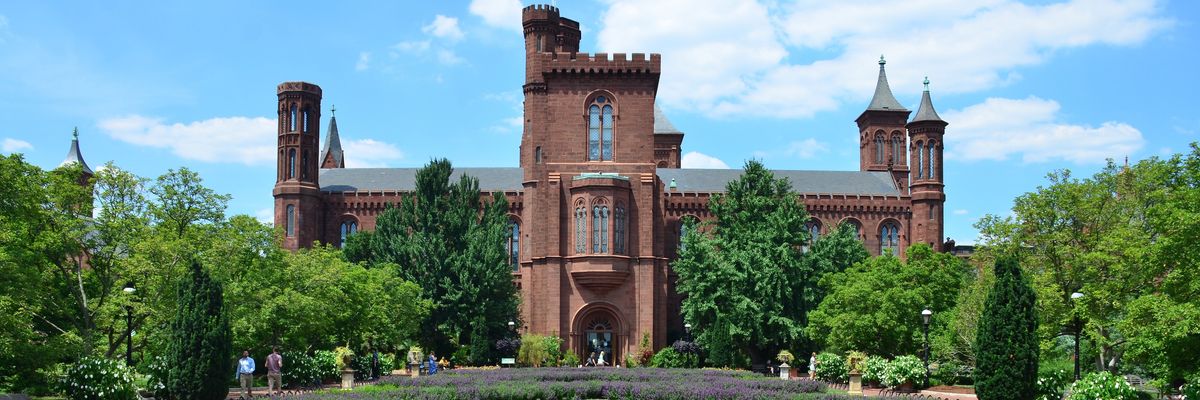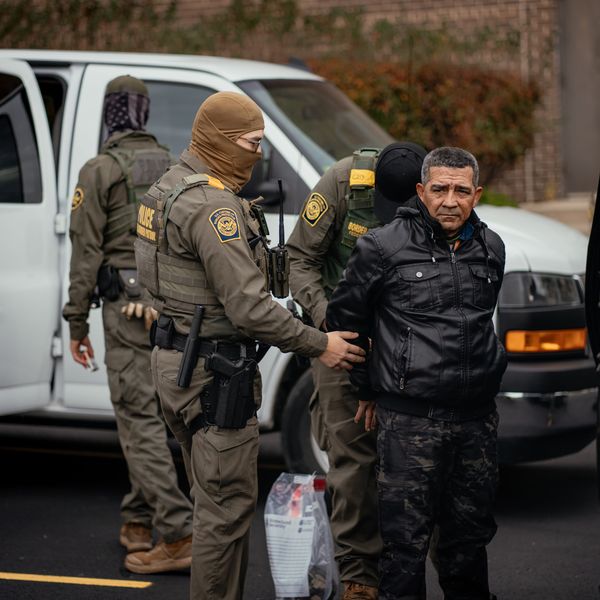
The Smithsonian Institution in Washington, D.C. is seen in this photograph taken on July 28, 2018.
'Horrid and Typical': WaPo Investigation Reveals Smithsonian Still Has 'Racial Brain Collection'
"How could they hold a child’s brain for 70 years, and know who he is?" a descendant of one victim asked. "It was my grandma's pain, and now that she's gone, it's my pain."
A Washington Post investigation published Monday revealed that the Smithsonian Institute in Washington, D.C. continues to hold hundreds of brains poached mostly from Black and Indigenous people in scores of countries by a white supremacist curator in the early 20th century without consent, and that the venerable institution has been slow to return the remains to the families of those affected.
According to Post reporters Nicole Dungca and Claire Healy, there are more than 250 brains in the Smithsonian's collection, the vast majority of them from people of color. The report states that the Smithsonian's National Museum of Natural History has more than 30,000 human bones and other body parts in storage.
Nearly all of the brains in the Smithsonian's possession were taken without the consent of the deceased persons or their relatives for the collection of Aleš Hrdlička—a eugenicist who served as curator of the Smithsonian's physical anthropology division—who sought to prove that white people are superior to people of other races.
As Dungca and Healy noted:
Most of the brains were removed upon death from Black and Indigenous people and other people of color. They are part of a collection of at least 30,700 human bones and other body parts still held by the Natural History Museum, the most-visited museum within the Smithsonian. The collection, one of the largest in the world, includes mummies, skulls, teeth, and other body parts, representing an unknown number of people.
The remains are the unreconciled legacy of a grisly practice in which bodies and organs were taken from graveyards, battlefields, morgues, and hospitals in more than 80 countries. The decadeslong effort was financed and encouraged by the taxpayer-subsidized institution. The collection, which was mostly amassed by the early 1940s, has long been hidden from view.
The Post located the descendants of Mary Sara, an Indigenous Sami woman whose brain was removed and sent to the Smithsonian after she died of tuberculosis in Seattle in 1933. Her preserved brain remains in the institute's collection. Mary Sara's relatives had no idea that her brain had been taken.
"It's a violation against our family and against our people," said Fred Jack, who is married to one of Sara's cousins. "It's kind of like an open wound... We want to have peace and we'll have no peace because we know this exists, until it's corrected."
The Smithsonian also hired two researchers to study and implement the ethical return of the brains and other remains.
"At the Smithsonian, we recognize certain collection practices of our past were unethical," wrote Bunch. "What was once standard in the museum field is no longer acceptable. We acknowledge and apologize for the pain our historical practices have caused people, their families, and their communities, and I look forward to the conversations this initiative will generate in helping us perform our cutting-edge research in a manner that is ripe with scholarship and conforms to the highest ethical standard."
In an interview with the Post, Bunch said that "I know that so much of this has been based on racist attitudes, that these brains were really people of color to demonstrate the superiority of white brains, so I understand that is just really unconscionable."
"And I think it's important for me as a historian to say that all the remains, all the brains, need to be returned if possible, [and] treated in the best possible way," he added.
However, the Post report claims the Smithsonian has "lagged in its efforts to return the vast majority of the remains" to their rightful recipients, with the institute so far having repatriated just four of the 268 brains in its possession.
Some of the brains in Hrdlicka's collection came from Filipinos who died after they were brought to the United States—which had recently conquered the Philippines from Spain—to be put on display in what critics have called a "human zoo" during the 1904 World's Fair in St. Louis.
The National Museum of the Philippines responded to the Post report in a statement welcoming the Smithsonian's repatriation efforts.
Some of the Filipino victims' brains were incinerated after their deaths. Victoria Tauli-Corpuz, who is Kankanaey Igorot Filipino and a former U.N. special rapporteur on the rights of Indigenous peoples, explained the importance of keeping the remains of deceased people whole.
"For Indigenous people, it's not just an issue, of course, of a violation of their rights," she told the Post. "It's also an issue of spiritual consideration."
This has long been an issue. The decapitated and preserved heads of Native Americans killed during the genocidal U.S. conquest of North America were labeled "specimens of natural history" and shipped off to the Smithsonian as far back as the 1870s, when the pseudoscience of phrenology—the study of human skulls to discern or predict mental traits of different races—was still in vogue.
Some people said they will remain troubled by the harm done to their ancestors even after their remains are returned. Lena Lauth, the granddaughter of 10-year-old Tlingit boy from Alaska whose brain was taken, asked, "How could they hold a child's brain for 70 years, and know who he is?"
"It was my grandma's pain," Lauth told the Post, "and now that she's gone, it's my pain."
An Urgent Message From Our Co-Founder
Dear Common Dreams reader, The U.S. is on a fast track to authoritarianism like nothing I've ever seen. Meanwhile, corporate news outlets are utterly capitulating to Trump, twisting their coverage to avoid drawing his ire while lining up to stuff cash in his pockets. That's why I believe that Common Dreams is doing the best and most consequential reporting that we've ever done. Our small but mighty team is a progressive reporting powerhouse, covering the news every day that the corporate media never will. Our mission has always been simple: To inform. To inspire. And to ignite change for the common good. Now here's the key piece that I want all our readers to understand: None of this would be possible without your financial support. That's not just some fundraising cliche. It's the absolute and literal truth. We don't accept corporate advertising and never will. We don't have a paywall because we don't think people should be blocked from critical news based on their ability to pay. Everything we do is funded by the donations of readers like you. Will you donate now to help power the nonprofit, independent reporting of Common Dreams? Thank you for being a vital member of our community. Together, we can keep independent journalism alive when it’s needed most. - Craig Brown, Co-founder |
A Washington Post investigation published Monday revealed that the Smithsonian Institute in Washington, D.C. continues to hold hundreds of brains poached mostly from Black and Indigenous people in scores of countries by a white supremacist curator in the early 20th century without consent, and that the venerable institution has been slow to return the remains to the families of those affected.
According to Post reporters Nicole Dungca and Claire Healy, there are more than 250 brains in the Smithsonian's collection, the vast majority of them from people of color. The report states that the Smithsonian's National Museum of Natural History has more than 30,000 human bones and other body parts in storage.
Nearly all of the brains in the Smithsonian's possession were taken without the consent of the deceased persons or their relatives for the collection of Aleš Hrdlička—a eugenicist who served as curator of the Smithsonian's physical anthropology division—who sought to prove that white people are superior to people of other races.
As Dungca and Healy noted:
Most of the brains were removed upon death from Black and Indigenous people and other people of color. They are part of a collection of at least 30,700 human bones and other body parts still held by the Natural History Museum, the most-visited museum within the Smithsonian. The collection, one of the largest in the world, includes mummies, skulls, teeth, and other body parts, representing an unknown number of people.
The remains are the unreconciled legacy of a grisly practice in which bodies and organs were taken from graveyards, battlefields, morgues, and hospitals in more than 80 countries. The decadeslong effort was financed and encouraged by the taxpayer-subsidized institution. The collection, which was mostly amassed by the early 1940s, has long been hidden from view.
The Post located the descendants of Mary Sara, an Indigenous Sami woman whose brain was removed and sent to the Smithsonian after she died of tuberculosis in Seattle in 1933. Her preserved brain remains in the institute's collection. Mary Sara's relatives had no idea that her brain had been taken.
"It's a violation against our family and against our people," said Fred Jack, who is married to one of Sara's cousins. "It's kind of like an open wound... We want to have peace and we'll have no peace because we know this exists, until it's corrected."
The Smithsonian also hired two researchers to study and implement the ethical return of the brains and other remains.
"At the Smithsonian, we recognize certain collection practices of our past were unethical," wrote Bunch. "What was once standard in the museum field is no longer acceptable. We acknowledge and apologize for the pain our historical practices have caused people, their families, and their communities, and I look forward to the conversations this initiative will generate in helping us perform our cutting-edge research in a manner that is ripe with scholarship and conforms to the highest ethical standard."
In an interview with the Post, Bunch said that "I know that so much of this has been based on racist attitudes, that these brains were really people of color to demonstrate the superiority of white brains, so I understand that is just really unconscionable."
"And I think it's important for me as a historian to say that all the remains, all the brains, need to be returned if possible, [and] treated in the best possible way," he added.
However, the Post report claims the Smithsonian has "lagged in its efforts to return the vast majority of the remains" to their rightful recipients, with the institute so far having repatriated just four of the 268 brains in its possession.
Some of the brains in Hrdlicka's collection came from Filipinos who died after they were brought to the United States—which had recently conquered the Philippines from Spain—to be put on display in what critics have called a "human zoo" during the 1904 World's Fair in St. Louis.
The National Museum of the Philippines responded to the Post report in a statement welcoming the Smithsonian's repatriation efforts.
Some of the Filipino victims' brains were incinerated after their deaths. Victoria Tauli-Corpuz, who is Kankanaey Igorot Filipino and a former U.N. special rapporteur on the rights of Indigenous peoples, explained the importance of keeping the remains of deceased people whole.
"For Indigenous people, it's not just an issue, of course, of a violation of their rights," she told the Post. "It's also an issue of spiritual consideration."
This has long been an issue. The decapitated and preserved heads of Native Americans killed during the genocidal U.S. conquest of North America were labeled "specimens of natural history" and shipped off to the Smithsonian as far back as the 1870s, when the pseudoscience of phrenology—the study of human skulls to discern or predict mental traits of different races—was still in vogue.
Some people said they will remain troubled by the harm done to their ancestors even after their remains are returned. Lena Lauth, the granddaughter of 10-year-old Tlingit boy from Alaska whose brain was taken, asked, "How could they hold a child's brain for 70 years, and know who he is?"
"It was my grandma's pain," Lauth told the Post, "and now that she's gone, it's my pain."
A Washington Post investigation published Monday revealed that the Smithsonian Institute in Washington, D.C. continues to hold hundreds of brains poached mostly from Black and Indigenous people in scores of countries by a white supremacist curator in the early 20th century without consent, and that the venerable institution has been slow to return the remains to the families of those affected.
According to Post reporters Nicole Dungca and Claire Healy, there are more than 250 brains in the Smithsonian's collection, the vast majority of them from people of color. The report states that the Smithsonian's National Museum of Natural History has more than 30,000 human bones and other body parts in storage.
Nearly all of the brains in the Smithsonian's possession were taken without the consent of the deceased persons or their relatives for the collection of Aleš Hrdlička—a eugenicist who served as curator of the Smithsonian's physical anthropology division—who sought to prove that white people are superior to people of other races.
As Dungca and Healy noted:
Most of the brains were removed upon death from Black and Indigenous people and other people of color. They are part of a collection of at least 30,700 human bones and other body parts still held by the Natural History Museum, the most-visited museum within the Smithsonian. The collection, one of the largest in the world, includes mummies, skulls, teeth, and other body parts, representing an unknown number of people.
The remains are the unreconciled legacy of a grisly practice in which bodies and organs were taken from graveyards, battlefields, morgues, and hospitals in more than 80 countries. The decadeslong effort was financed and encouraged by the taxpayer-subsidized institution. The collection, which was mostly amassed by the early 1940s, has long been hidden from view.
The Post located the descendants of Mary Sara, an Indigenous Sami woman whose brain was removed and sent to the Smithsonian after she died of tuberculosis in Seattle in 1933. Her preserved brain remains in the institute's collection. Mary Sara's relatives had no idea that her brain had been taken.
"It's a violation against our family and against our people," said Fred Jack, who is married to one of Sara's cousins. "It's kind of like an open wound... We want to have peace and we'll have no peace because we know this exists, until it's corrected."
The Smithsonian also hired two researchers to study and implement the ethical return of the brains and other remains.
"At the Smithsonian, we recognize certain collection practices of our past were unethical," wrote Bunch. "What was once standard in the museum field is no longer acceptable. We acknowledge and apologize for the pain our historical practices have caused people, their families, and their communities, and I look forward to the conversations this initiative will generate in helping us perform our cutting-edge research in a manner that is ripe with scholarship and conforms to the highest ethical standard."
In an interview with the Post, Bunch said that "I know that so much of this has been based on racist attitudes, that these brains were really people of color to demonstrate the superiority of white brains, so I understand that is just really unconscionable."
"And I think it's important for me as a historian to say that all the remains, all the brains, need to be returned if possible, [and] treated in the best possible way," he added.
However, the Post report claims the Smithsonian has "lagged in its efforts to return the vast majority of the remains" to their rightful recipients, with the institute so far having repatriated just four of the 268 brains in its possession.
Some of the brains in Hrdlicka's collection came from Filipinos who died after they were brought to the United States—which had recently conquered the Philippines from Spain—to be put on display in what critics have called a "human zoo" during the 1904 World's Fair in St. Louis.
The National Museum of the Philippines responded to the Post report in a statement welcoming the Smithsonian's repatriation efforts.
Some of the Filipino victims' brains were incinerated after their deaths. Victoria Tauli-Corpuz, who is Kankanaey Igorot Filipino and a former U.N. special rapporteur on the rights of Indigenous peoples, explained the importance of keeping the remains of deceased people whole.
"For Indigenous people, it's not just an issue, of course, of a violation of their rights," she told the Post. "It's also an issue of spiritual consideration."
This has long been an issue. The decapitated and preserved heads of Native Americans killed during the genocidal U.S. conquest of North America were labeled "specimens of natural history" and shipped off to the Smithsonian as far back as the 1870s, when the pseudoscience of phrenology—the study of human skulls to discern or predict mental traits of different races—was still in vogue.
Some people said they will remain troubled by the harm done to their ancestors even after their remains are returned. Lena Lauth, the granddaughter of 10-year-old Tlingit boy from Alaska whose brain was taken, asked, "How could they hold a child's brain for 70 years, and know who he is?"
"It was my grandma's pain," Lauth told the Post, "and now that she's gone, it's my pain."

